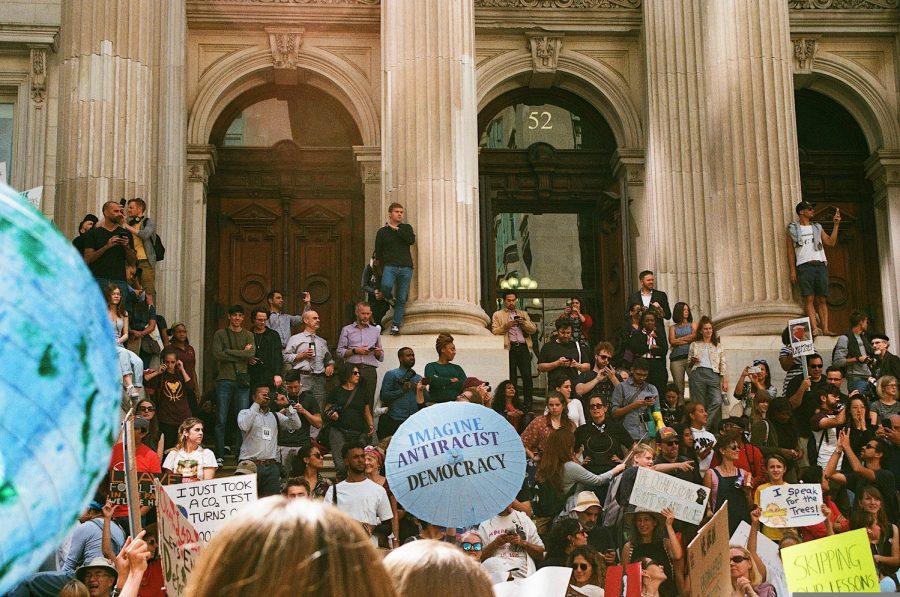What is the Next Step For the Youth Climate Justice Movement?
Student climate justice activists from across New York City organized the September 20, 2020 Climate Strike, the largest day of environmental action to date.
After a year of furtive protesting, climate activists across the world took to their laptops to celebrate the fiftieth anniversary of Earth Day. The original marches and demonstrations were replaced by an online platform following the onset of social distancing regulations due to the Coronavirus pandemic. Edie Fine ’21, an organizer with Extinction Rebellion, said, “Earth Day Live reinforced some of the things that I already knew about the climate justice movement. The youth climate movement is unstoppable, and it can persist through most obstacles (even a global pandemic). We are adaptable in an incredibly inspiring way, and we can turn to methods of organizing that have either previously been unknown to us, or are drastically different than what we’re used to.”
In a 36-hour long Livestream, climate leaders, celebrities, and musicians spoke, performed, and shared their experiences with climate change activism, urging governments and leaders to take monumental steps in mitigating climate change and environmental degradation. The Livestream event was attended by more than 100,000 unique viewers over the three days, an impressive feat for only three weeks of coordination. The spectacle, combined with the onset of the novel Coronavirus pandemic and the drastic changes to our daily lives, leaves the activist community at a loss.
Traditional climate strikes revolved around people power — students brandishing artistic signage and calling for immediate system change. Many organizations like Extinction Rebellion Youth U.S, The Sunrise Movement, and TREEage call for this kind of grassroots, community-engaged organizing in order to advocate for climate action. Reminiscent of past protests, students at climate strikes would typically give off-the-cuff speeches to the assembled crowd through megaphones, and lead chants like “system change, not climate change” in order to get the attention of the press and elected officials. The virtual replacement, Earth Day Live, fell short of the people-power model. This time around, the United States Youth Climate Movement relied on celebrities and classic crowd-pleasers in order to gain attention, illustrating the new mold that mainstream activism has fit into, one that is essentially watered down.
Op-eds hailed Earth Day Live as a powerful attempt to continue environmental advocacy amidst an all-consuming pandemic, and a not-so-subtle reminder that the cogs of climate change keep turning while the world sits at home. And yet, nearly four weeks after Earth Day Live and a year of international climate strikes, not enough progress has been made that extends beyond greater awareness of the climate crisis. The time has come for the climate movement to reconsider its strategy and to opt for more radical methods of organizing, ones that champion explicit political lobbying, concrete demands, and frameworks for change.
Many arms of the climate movement are stuck to demanding a “Green New Deal” as their only concrete demand, without any framework for what that looks like, now that the original bill was shot down in Congress last summer. That kind of vague political messaging is neither an effective nor thoughtful strategy. Though the Office of the President, all 435 House seats, and 35 of the 100 Senate seats are up for reelection in 2020, the only real chance that the Green New Deal has of passing is if Democrats maintain control of the House, and win the Senate and the White House. And that’s a big ‘if.’
By focusing on local policy and community-oriented organizing, states will be able to develop a truly green economy that emphasizes principles of justice, setting the stage for other states to do the same. And there is no better time than the present; with the price of oil at a record low, and unemployment around a staggering 25%, states have an opportunity to enact local Green New Deals that create opportunities for employment while championing renewable energy.
The New York State Senate paved the way for a local Green New Deal when it passed the Climate Leadership and Community Protection Act (S6599) in 2019 in a landmark for environmental and labor protections. The CLCPA sets out to “adopt measures to put the state on a path to reduce statewide greenhouse gas emissions by eighty-five percent by two thousand fifty and net-zero emissions in all sectors of the economy.”
To fulfill Section 4, which establishes that the Senate must “amend the Public Service Law to establish a renewable energy program designed to achieve a minimum of 70 percent of statewide electric generation be secured by renewable energy systems by 2030 and zero emissions from the statewide electrical demand system in 2040,” local organizations ought to capitalize on our state’s economic disparity by building partnerships with labor unions to lobby for the creation of green jobs.
The time has come for the mainstream climate movement to get its act together and to effectively strategize to get the ball rolling for lasting climate change mitigation through political mobilization.
The time has come for the climate movement to reconsider its strategy and to opt for more radical methods of organizing.
Azalea Danes is a Copy Chief for ‘The Science Survey.’ She is fascinated in honing her writing skills by reading and editing others’ work, and enjoys...
Lavanya Manickam is an Editor-in-Chief for ‘The Science Survey.’ She enjoys writing narratives that provide insight into various perspectives, and...











